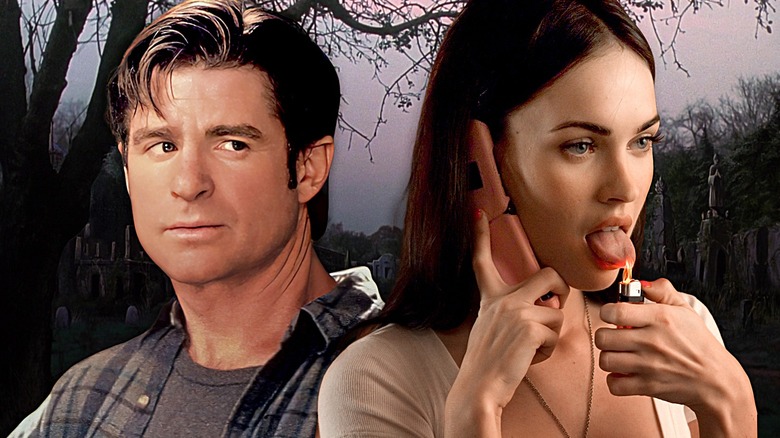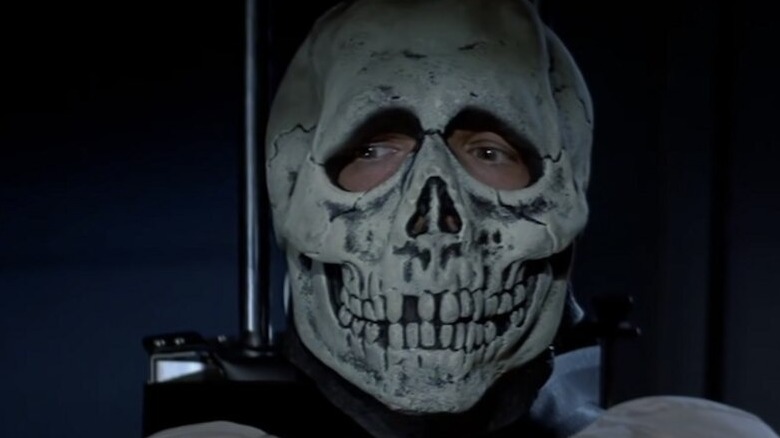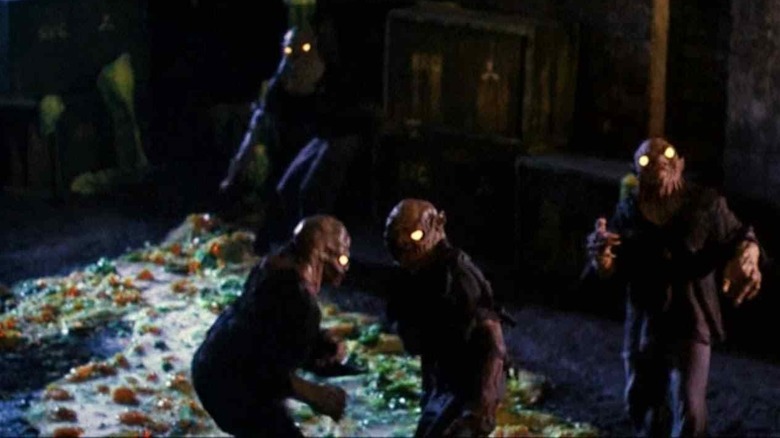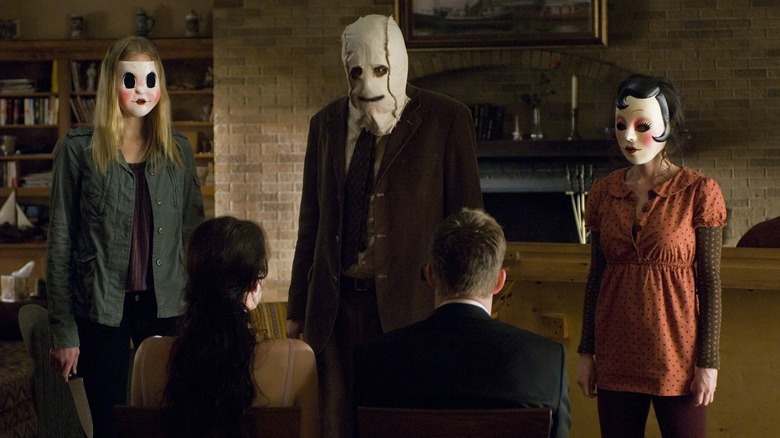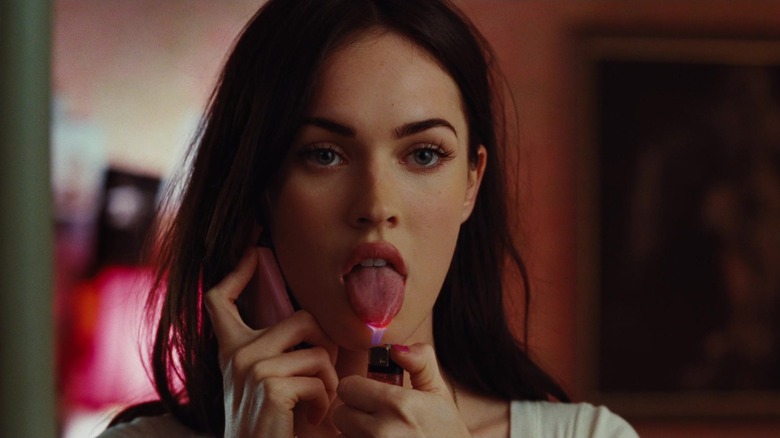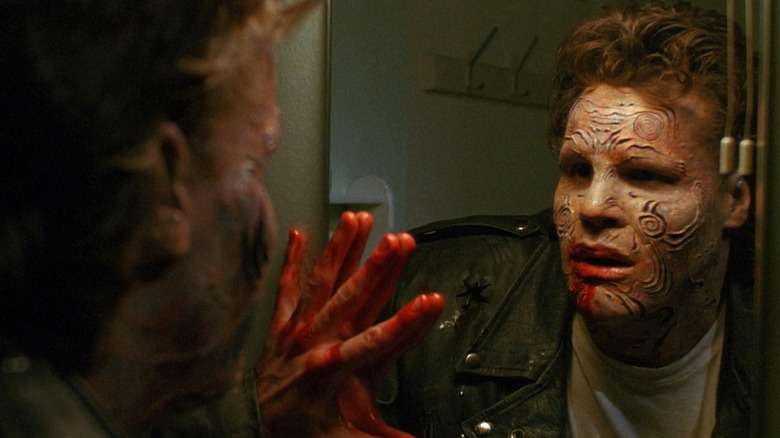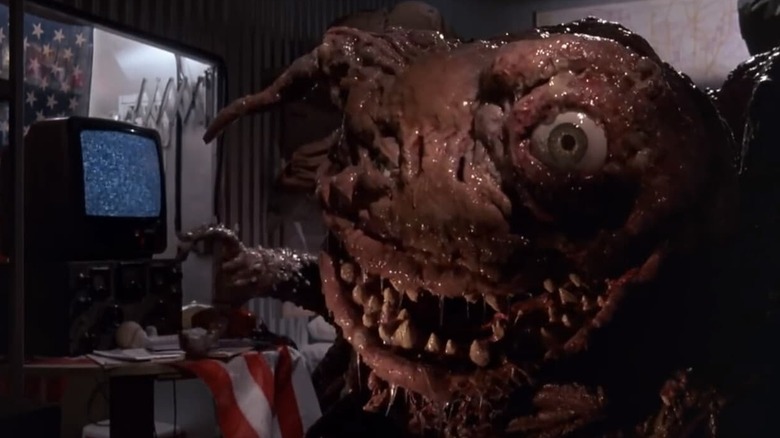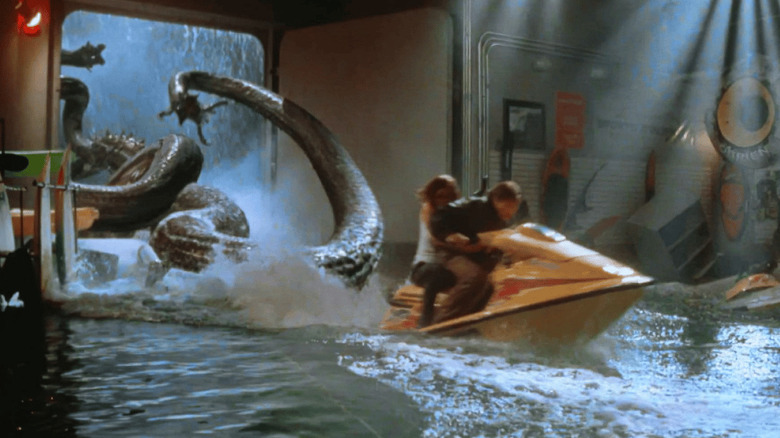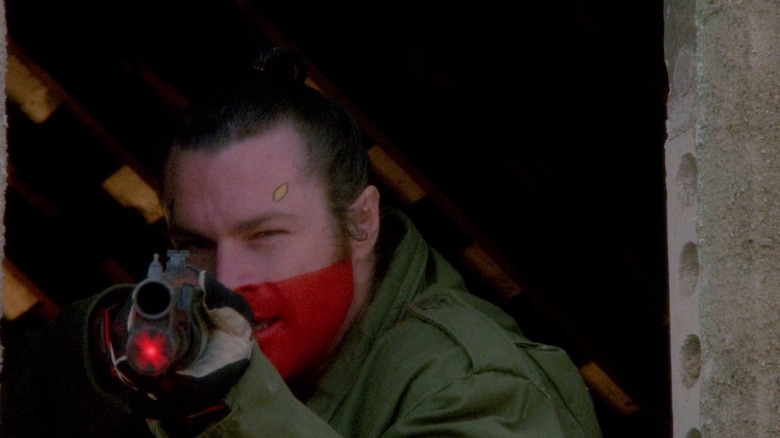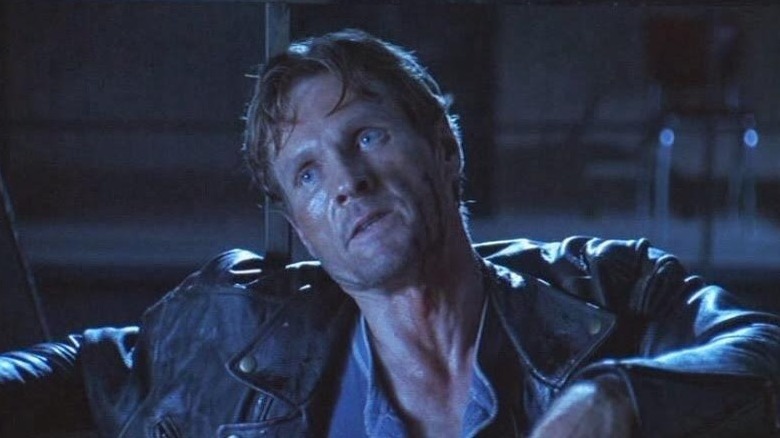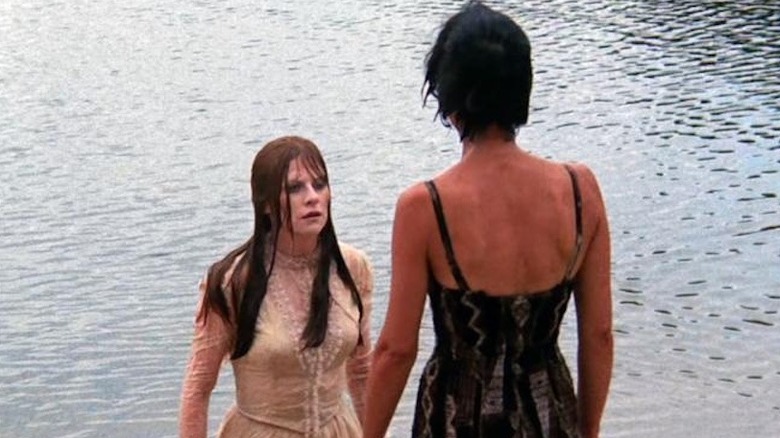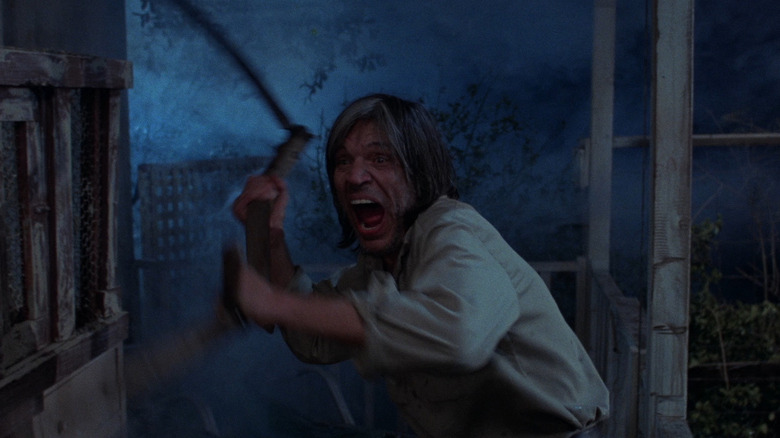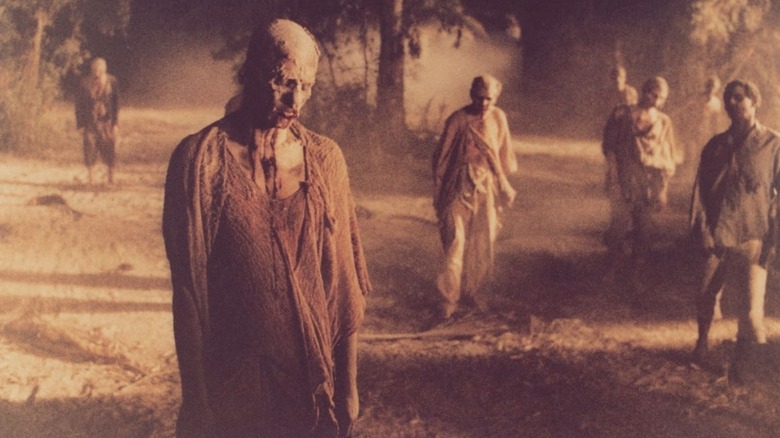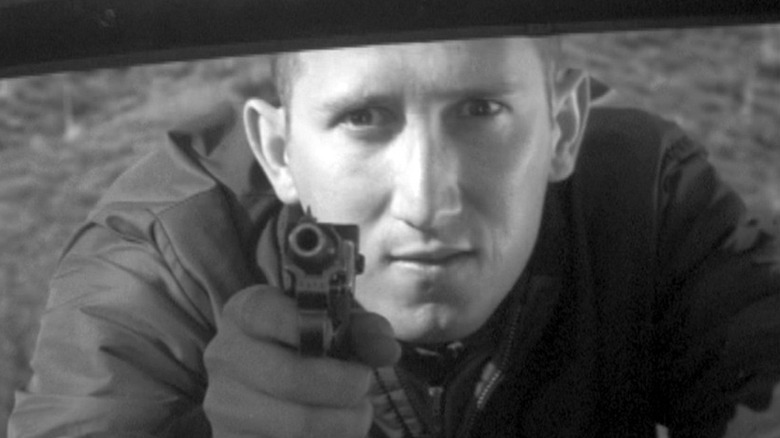Horror Movies With Terrible Rotten Tomatoes Scores That Are Actually Worth Watching
Like all movie ranking sites, Rotten Tomatoes likes to post its own "best of" lists of film genres, and horror movies are no exception. Its list of what it considers the 200 Best Horror Movies is, for the most part, unimpeachable: you'll find the 1931 "Dracula" alongside "Alien" and even recent releases like "Barbarian" in its ranking. But as you scroll through the 200 titles, chances are, you'll find titles that might give pause for their inclusion: Does "Zombieland" really merit being placed above classics like "The Birds" and "The Innocents"? And even though it resides at No. 169, "Saw X" — really?
All this to say that movie rankings, no matter the genre, are highly subjective, and one person's classic is another person's trash. A scan of Rotten Tomatoes' horror listings bears out that notion: There are dozens, if not hundreds of fright films that reside far down on the Tomatometer but have ardent fanbases and have been rediscovered since their initial releases. Here is a list of horror films that, despite their lousy ranks on Rotten Tomatoes, are more than worth your time.
Halloween III: Season of the Witch
In an interview for Yahoo! Movies, "The Guest" screenwriter Simon Barrett summed up the reaction of audiences to "Halloween III: Season of the Witch" upon its release and the three-decade about-face that transformed the film into a cult favorite. "I saw 'Halloween III' when I was 10 or 11, during that period when I'd rent everything from the horror section in the video store," he recalled. "I watched it with a couple of friends, and they were like, 'This is bulls***! Where's Michael Myers?' Then you get to the end, and you think, 'Wait, that was actually pretty cool!'"
Released to negative acclaim and tepid box office returns in 1982, "Halloween III" was blasted for its bizarre storyline: A Halloween mask company owner (Dan O'Herlihy) implants fragments of Stonehenge in his products to sacrifice children for ancient rituals. Audiences and critics disliked its downbeat ending and, most importantly, its lack of Michael Myers, despite John Carpenter and Debra Hill returning as producers. While it seems like some audiences are still unhappy over that omission — resulting, perhaps, in its 50% critic rating and 29% audience score on Rotten Tomatoes – others find its mix of chills and cracked conspiracy theories a satisfying horror experience, even without Michael Myers. As director Tommy Lee Wallace told Yahoo!, "'Halloween III' found its audience. There are a lot of us out there who think it's a pretty darn good movie."
C.H.U.D.
It's possible that you may have heard a reference to "C.H.U.D" in episodes of "The Simpsons" or "Ricky and Morty" (or some highly contentious memes); you might have also caught a glimpse of a "C.H.U.D" VHS tape in the opening frames of Jordan Peele's "Us." "C.H.U.D." refers to Cannibalistic Humanoid Underground Dwellers, as well as the 1984 film of the same name, which featured a pre-"Home Alone" team-up of John Heard and Daniel Stern, who discover that chemical waste has turned members of New York's unhoused population into monsters. Watch carefully, and you'll also see John Goodman and Jay Thomas as cops and Patricia Richardson of "Home Improvement" in the cast.
If that premise sounds like pure B-movie fodder, it is, and most likely, it's also why "C.H.U.D." enjoys a 29% rating on Rotten Tomatoes. However, it's developed a cult following over the past three decades as a taut, suspenseful, and surprisingly smart thriller that also happens to feature sewer-dwelling monsters. The New York Times supported it back in 1984, with writer Lawrence Van Gelder noting its "knowing feel for the atmosphere of New York City, occasional flashes of wit in the script by Parnell Hall, and commendable restraint ... in the administration of the requisite doses of monsters."
The Strangers
What's the deal with the middling response for "The Strangers"? The 2008 thriller from Bryan Bertino, about a couple who is terrorized by a trio of masked intruders, was a modest hit upon release and enjoys a cult following today. It's even spawned a franchise with "Strangers: Prey at Night" and a new trilogy from Lionsgate. With that longevity, why does the original "Strangers" only rate 49% on Rotten Tomatoes? The most likely answer is negative reviews from squeamish critics, who found the psychological games played by the Strangers unpleasant, like NPR's Bob Mondello, who called it a "sadistic, unmotivated home-invasion flick."
"The Strangers" is intense, but its reputation is built on its nerve-rattling suspense and the horror of its premise, which was reportedly inspired by disturbing real-life events. The actual gore is surprisingly low, so if that's the factor keeping you from watching the film, put your worries aside. You should be prepared, however, to remain on the edge of your seat for the full running time; as Michael Rechtshaffen with The Hollywood Reporter noted, it's a "spare, creepily atmospheric psychological thriller with a death grip on the psychological aspect."
Jennifer's Body
"Lisa Frankenstein" screenwriter Diablo Cody's first foray into horror, "Jennifer's Body," has finally found its audience despite a dismal box office performance. Shortly after winning the 2007 Oscar for her script for "Juno," Cody wrote the 2009 horror-comedy about a nerdy high schooler (Amanda Seyfried) who discovers that her popular friend (Megan Fox) was murdered and then possessed by a ravenous demon with an appetite for male suitors. As with Cody's "Lisa Frankenstein," critical and fan response to "Jennifer's Body" was mixed, and its current Rotten Tomatoes score is a middling 46%.
Don't let that scare you off from seeing "Jennifer's Body." The film has enjoyed critical and fan reappraisals in the past decade, and especially during the #MeToo movement: as Constance Grady noted for Vox, "What 'Jennifer's Body' offers up in response to the trauma and tragedy of what happened to Jennifer ... is the cathartic fantasy of what happens next, of Jennifer turning her trauma against her attackers, of her using her victimized, violated body to wreak bloody vengeance on the patriarchy." Fans of Cody will be interested in some Easter eggs that even suggest a "Jennifer's Body"/"Lisa Frankenstein" cinematic universe.
Nightbreed
1987's "Hellraiser" marked novelist Clive Barker as major figure on the rise in horror movies. However, that ascent was cut short with his second film, 1990's "Nightbreed." Barker's story is a fantasy-horror hybrid about a troubled man (Craig Sheffer) who flees the influence of his serial killer therapist (David Cronenberg) for an underground community of monsters. The film baffled 20th Century Fox, which forced Barker to trim nearly an hour from his cut and released it to without critical previews. As a result, "Nightbreed" flopped, and the truncated version sits at 53% on Rotten Tomatoes.
Barker's fervent wish for the release of his original edit came to pass in 2014 with a Blu-ray release from Shout! Factory. That's the version that's worth seeing: It reduces Cronenberg's presence and offers an intriguing conclusion that foreshadows Barker's intention to form a trilogy around "Nightbreed." The Director's Cut also places greater emphasis on the Nightbreed themselves, transforming them into full-fledged characters. Recently, critics have praised the story as an effective allegory for the queer community. "The director's cut allows us more time with the creatures and ups their number, emphasizing that they're only fearsome to those afraid of difference," wrote Charles Bramesco for The A.V. Club.
TerrorVision
The 1986 horror science-fiction comedy "TerrorVision" has a 10% rating on Rotten Tomatoes, which generally suggests a truly terrible film. That's a harsh verdict for director Ted Nicolaou and Empire Pictures, which gave us "Troll" and "Ghoulies," but also the classic "Re-Animator." "TerrorVision" sits somewhere between those two poles: Its story, about a TV-obsessed family whose new satellite antenna brings a hungry alien to Earth, is steeped in cheap gags and special effects, but also manages to be genuinely funny (though very un-PC) and unexpectedly clever and even takes a few shots at '80s consumerist culture.
Any success enjoyed by "TerrorVision" is due to its cast of cult favorites like Gerrit Graham, Mary Woronov, Robert Altman regular Bert Remsen, and Diane Franklin, as well as a pre-"Napoleon Dynamite" Jon Gries. All seem to embrace the broad humor of Nicolaou's script and invest it with vibrant energy. The writers deliver low-brow gags — gloppy aliens, buxom horror movie hosts — for the grindhouse-minded but also wisely skewer the family for being so stupid that they not only invite the alien into their home but also blow their chance to defeat it. "This bright, kooky, and hilarious movie accomplishes exactly what it sets out to do," wrote Jessica Scott for Certified Forgotten, "and it does so in an eminently engaging and entertaining way that has earned it a well-deserved cult status."
Deep Rising
Shortly before striking box office gold with "The Mummy" in 1999, Stephen Sommers wrote and directed 1998's "Deep Rising," a modestly budgeted science-fiction horror film. A host of negative reviews — including one by Roger Ebert, who later featured it on his Most Hated list — sank the film upon release, so you aren't to be faulted if you haven't heard of it. However, if you liked the action, creature feature thrills, and humor in "The Mummy," you'll enjoy "Deep Rising" as well — despite its 34% Rotten Tomatoes rating.
Like "The Mummy," "Deep Rising" follows a blueprint from classic Hollywood and B-pictures: There's a fast-talking hero (Treat Williams) and a clever heroine (Famke Janssen), a host of bad guys (including Wes Studi, Anthony Heald, and Djimon Hounsou), and an insurmountable monster: a colossal, Lovecraftian sea creature with a taste for passenger ships. The dialogue is breezy, the action briskly paced, and the monster scenes appropriately gross. If there's an issue with "Deep Rising," it's the budget, which can undermine its special effects and production design. If you can see past that, you'll most likely agree with Ty Burr's assessment for Entertainment Weekly: "It's pretty darn wonderful — a tightly written, often howlingly funny 'Aliens' knockoff that, in its portrayal of tough men and tougher women under pressure, favorably recalls the work of Howard Hawks."
White of the Eye
The 1987 thriller "White of the Eye" is not easy to watch or digest. It's the penultimate film from Scottish cult director Donald Cammell, who rose to fame in 1970 with the disorienting "Performance," which featured Mick Jagger as a mysterious pop singer. All of Cammell's films play with issues of reality and perception, often through hallucinatory film techniques (editing and music, in particular), and "White of the Eye" is no exception.
"White of the Eye" is at first a film about a serial killer murdering women in a ritualistic fashion, and in that regard, it's absolutely harrowing (one murder involves the killer forcing his victim to watch her own death). It blossoms into an obsessive triangle among a sound engineer (David Keith), his wife (Cathy Moriarty of "Raging Bull"), and her ex-husband (Alan Rosenberg), which unfolds in numerous dizzying flashbacks. The structure of the film is most likely the reason for the middling 50% rating on Rotten Tomatoes, but in a decade filled with cheap slashers, Cammell's extraordinary visuals and violence reward adventurous horror fans. As Graeme Clark of The Spinning Image noted, "There are few serial killer films that would be brave enough to take Cammell's approach, and that's what distinguishes this work: there's nothing exactly like it."
Tales from the Crypt: Demon Knight
The first of two official theatrical movies spun off from HBO's "Tales from the Crypt" series (2002's "Ritual" was repackaged as a "Crypt" movie), "Tales from the Crypt: Demon Knight" stars William Sadler as a drifter who fends off the demonic Collector (Billy Zane) with a sacred artifact. Loaded with gory violence and special effects, "Demon Knight" was dismissed upon release. But it's not short on talent, with acclaimed cinematographer Ernest Dickerson as director and a cast that included Jada Pinkett, CCH Pounder, Thomas Haden Church, and cult movie legend Dick Miller.
Its 42% rating on Rotten Tomatoes doesn't do "Demon Knight" justice. If you're looking for the same level of carnage as the best episodes of the "Crypt" series, it absolutely delivers: Heads and limbs are torn from bodies, and demons are blown apart with abandon. It's also true to the dark humor and hyper-stylized aesthetic of the '50s horror comics on which the series was based: as Stephen Holden with The New York Times noted, "What 'Tales from the Crypt' does best is sustain a look and tone that bring a comic-book's broad strokes into the realm of a live-action movie without seeming too mannered or arty." Most importantly, it's way better than the second "Crypt" movie, "Bordello of Blood."
Let's Scare Jessica to Death
One faction of horror fans wants their scares served up without any illusions and preferably raw and bloody. But another section of that demographic understands H.P. Lovecraft's declaration that the oldest and strongest kind of fear is the fear of the unknown and relishes horror movies that require patience when doling out scares. The former group is likely responsible for the underrated '70s horror movie "Let's Scare Jessica to Death" earning a 36% rating on Rotten Tomatoes.
The film, which concerns a psychologically fragile woman (Zohra Lampert) beset by a vampire and its lumbering servants, trucks in lingering, surreal frights over buckets of blood. If that's not your cup of chills, "Jessica" will be a disappointment. But if your brand of horror doles out scares in tantalizing increments, be prepared to be rattled by "Let's Scare Jessica to Death." As the esteemed critic and author Kim Newman told Love Horror, "It was the first film to deliver on the promise of the X certificate, of grasping the heart and mind with icy fists, leaving a permanent impression on the psyche."
Eaten Alive
Much of the reason behind the 35% rating on Rotten Tomatoes for Tobe Hooper's "Eaten Alive" is due to what it's not rather than what it actually is. The 1976 film is not Hooper's intensely disturbing masterwork, "The Texas Chain Saw Massacre." "Eaten Alive" has more polish than its predecessor: It was filmed on a Hollywood soundstage, stars veteran Hollywood actors like Neville Brand and Carolyn Jones (as well as a young Robert Englund), and features a tone similar to the dark, "sick" humor of '50s-era horror comics. Audiences didn't like it, and even Hooper abandoned the film over conflicts with the producers.
But "Eaten Alive" has its own barely controlled energy that makes it worth a second look. The soundstage allowed Hooper to experiment with surreal lighting — sickly pinks and crimson reds — that roots the film somewhere between "Tales from the Crypt" and experimental theater. The huge cast of characters all seem on the verge of an anxiety attack as they attempt to kill or be killed; Brand's greasy lunatic, in particular, can't stop screaming about the crocodile that lives under his backwoods motel or cleaning its filthy rooms. As Stephen Thrower noted in "Nightmare USA" (via Acidemic), "In all its malformed glory it still commands respect for its unrelenting weirdness, its vicious hysteria, and Neville Brand's wonderful performance."
Zombie
Lucio Fulci's "Zombie" aka "Zombi 2" only rates 41% on Rotten Tomatoes – a surprisingly low rank for a film widely regarded by horror fans as one of the bloodiest and most shocking entries in the cycle of European carbon copies of George Romero's "Night of the Living Dead" and "Dawn of the Dead." (In fact, "Zombie" was marketed as a direct sequel to "Dawn" in Italy). "Zombie" had everything for the grindhouse and drive-in crowd: gruesome special effects, a fatalistic, no-way-out ending, and a memorable U.S. ad campaign anchored by the tagline "WE ARE GOING TO EAT YOU!" Yes, the effects and performances are sometimes primitive compared to modern zombie films, but again: 41%?
Phelim O'Neal for The Guardian wrote, "['Zombie'] delivers, plain and simple. You want gore? You want zombies? Then you'll want this film. ... Fulci's once banned 'video nasty' is perhaps the ultimate undead movie, making up in quality what it lacks in quantity." While it lacks strong, relatable characters and grand world-building, "Zombie" is nevertheless one of the best zombie movies you've probably never heard of. It's pure exploitation, designed solely to disgust and/or amuse. But what it does have? Waves of remorseless zombies, a death-knell synth score by Fabio Frizzi, and (literally) eye-popping special effects, including the sight of a stuntman in zombie makeup fighting a real shark underwater.
The Thrill Killers
If you know the cult indie director Ray Dennis Steckler at all, it's probably because of guilty pleasure horror films like "The Incredibly Strange Creatures Who Stopped Living and Became Mixed-Up Zombies," which veers from melodrama to horror to musical, often within the same scene. Steckler made films very quickly and for very little money, and the eccentricity of his output was a chief selling point. They aren't very good by Hollywood standards, but there was (and remains) nothing else like them. But Steckler could, under the right circumstances, turn out a film with mainstream appeal, such as his 1966 shocker "The Thrill Killers."
"The Thrill Killers" features Steckler's hallmarks: strange forays into other genres, a fragmented plot, and curious directorial choices determined by budgetary restraints. That explains its Rotten Tomatoes audience rating of 36% and two "Rotten" reviews out of three total. But once the film focuses on a couple (Joseph Bardo and Liz Renay, later the star of John Waters' "Desperate Living") caught between a psychopathic killer (Steckler) and three escaped mental patients — it becomes surprisingly suspenseful, thanks to stark black-and-white photography and the unfettered performances of the villains. Of course, Steckler can't completely reel in his odd aesthetic — the film ends with a motorcycle/horse chase — but as genre critic Nathaniel Thompson noted for Mondo Digital, "[This] film is shot far more skillfully than you'd expect with a handful of really fascinating visual touches scattered throughout."
